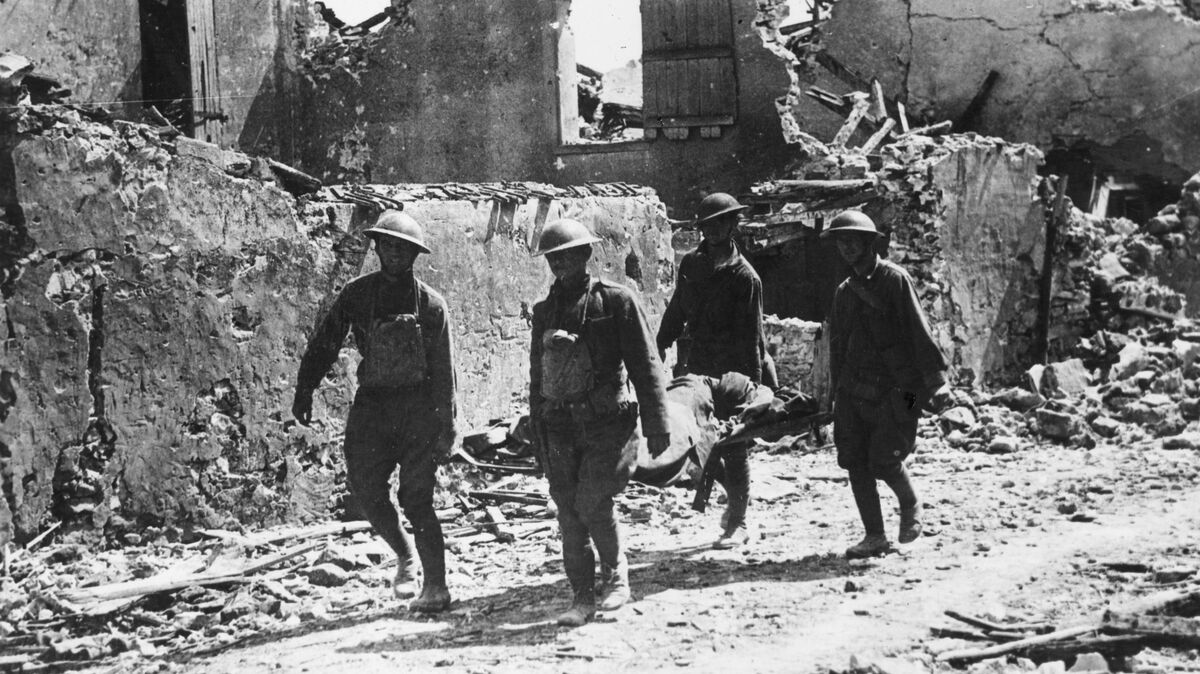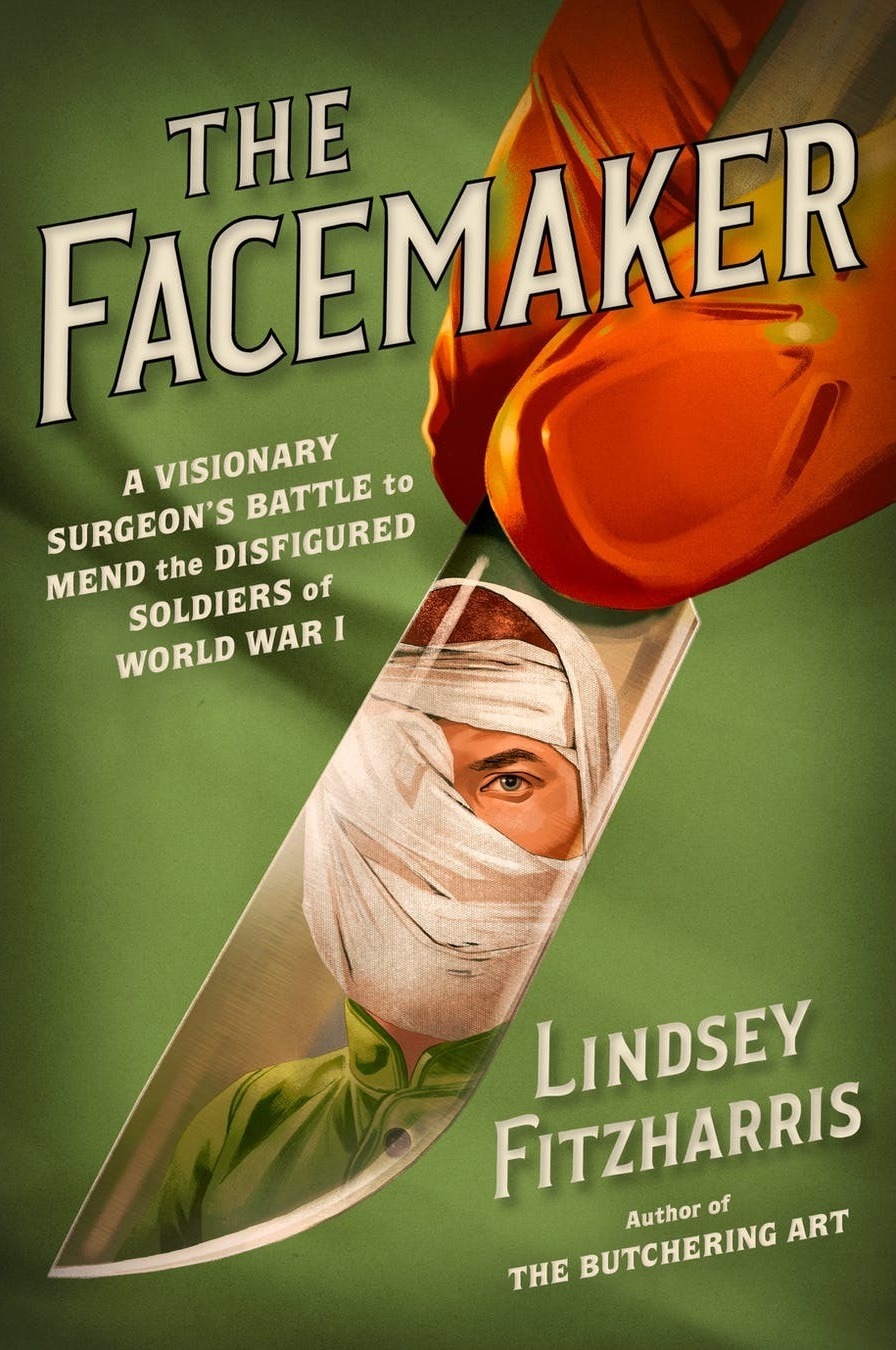[ad_1]
4 American troopers carry a wounded soldier on a stretcher in Vaux, France, on July 22, 1918. As many as 280,000 World Warfare I combatants have been left with facial accidents.
Sgt Adrian C. Duff/Getty Photos
disguise caption
toggle caption
Sgt Adrian C. Duff/Getty Photos

4 American troopers carry a wounded soldier on a stretcher in Vaux, France, on July 22, 1918. As many as 280,000 World Warfare I combatants have been left with facial accidents.
Sgt Adrian C. Duff/Getty Photos
The First World Warfare, which lasted from 1914 till 1918, ushered in a brand new type of mechanized warfare. Our bodies have been maimed, burned and gassed, and as many as 280,000 combatants have been left with ghastly facial accidents. Medical historian Lindsey Fitzharris says troopers who suffered facial accidents have been typically shunned in civilian life.
“The reactions could possibly be very excessive,” she says. “This was a time when dropping a limb made you a hero, however dropping a face made you a monster.”
In Britain, troopers with facial accidents have been known as the “loneliest Tommies.” Once they left the hospital grounds, they have been pressured to sit down on brightly painted blue benches in order that the general public knew not to have a look at them. The sphere of cosmetic surgery was nonetheless in its infancy, however one surgeon in England — Dr. Harold Gillies — endeavored to deal with the wounded. Fitzharris tells Gillies’ story within the new e-book, The Facemaker: A Visionary Surgeon’s Battle to Mend the Disfigured Troopers of World Warfare I.
It was pioneering work. Any surgeon keen to rebuild a soldier’s face needed to contemplate the lack of perform — such because the soldier’s incapacity to eat or to talk — as nicely the aesthetics of what would make the face socially acceptable by the requirements of the day. And there have been no textbooks to information the best way, nor have been antibiotics accessible.
“Gillies is admittedly working with out a internet. … He would not have anyone instructing him how to do that. He is actually acquired to make this up,” Fitzharris says. “You actually do should provide you with artistic options, which he completely does.”
Gillies lobbied the British Warfare workplace to determine a hospital to deal with facial accidents, and he banned mirrors in some wards so the newly injured would not be traumatized by their very own unrecognizable faces. He spent the battle changing misplaced pores and skin and restoring jaws, noses and enamel to provide 1000’s of veterans an opportunity to return to civilian life.
“What Harold Gillies is ready to do for these males is not only mend their damaged faces, but additionally mend their damaged spirits,” Fitzharris says. “That is what’s on the core of The Facemaker: It is about identification and what occurs to you while you lose that and the way do you regain that again? And that is finally what Gillies was capable of do for these males to assist them restore their identities.”
Interview highlights


On her use of the phrase “disfigured” within the e-book
I really labored with a incapacity activist named Ariel Henley, who’s the creator of a e-book known as A Face for Picasso, and we mentioned the language and the way I might find yourself describing a few of these accidents in these males’s experiences, and I do use the phrase “disfigured” on this e-book, which we would not use in the present day. We would use a phrase like “facial distinction.” However I felt it was necessary that I did not reduce that have for the reader, as a result of these males actually have been disfigured to the society they lived in.
On the problem of getting injured troopers off the battlefield
A face wound may be very bloody. It’s extremely ghastly. Anyone who’s even had a minor minimize on their face will comprehend it bleeds and it bleeds and it bleeds. And so numerous instances these stretcher bearers simply did not suppose that these wounds have been survivable. That they had by no means seen something like this earlier than. And naturally, they’re within the midst of the phobia of the battle as nicely, which does not assist. In order that they would go away these males behind.
There are tales, for example, of Personal Walter Ashworth who lays on the battlefield after the primary day of the Somme for 3 days with out a jaw, unable to scream for assist. And it is mind-boggling to us that anyone might simply be left there for therefore lengthy. However once more, these stretcher-bearers, they simply did not suppose that these have been survivable wounds. The opposite problem was that usually after they did take away these males, they’d, with good intentions, place these males on their backs, on the stretchers, and inadvertently they’d kill [them] as a result of they’d find yourself drowning in their very own blood, or they’d choke on their tongues as a result of they did not have the anatomy to carry their tongues [in] a traditional place. So the medical challenges have been immense. Simply getting off the battlefield was an actual problem for these males.
On Gillies having to restore the work carried out by trauma surgeons in area hospitals
Numerous instances these males have been pulled off the battlefield. They have been pulled from the trenches. They fell into the fingers of trauma surgeons. Now, you can think about near the entrance in these hospitals, there was numerous chaos round these surgeons. And actually their focus is to avoid wasting individuals’s lives. So numerous instances they have been simply stitching these wounds in a short time, making an attempt to cease the hemorrhaging, making an attempt to avoid wasting lives. And in doing so, typically they have been sealing these males’s destiny as a result of they have been suturing the micro organism from the battlefield into the face and into the wound. So when these males would get to Gillies, Gillies would typically should unpick numerous what had been carried out close to the entrance and begin over. The method of rebuilding a soldier’s face at the moment might take many months, generally years, and even over a decade in some situations.
On why Gillies banned mirrors within the hospital ward

Medical historian Lindsey Fitzharris writes about Dr. Harold Gillies in her new e-book, The Facemaker: A Visionary Surgeon’s Battle to Mend the Disfigured Troopers of World Warfare I.
Stuart Simpson/Penguin Random Home
disguise caption
toggle caption
Stuart Simpson/Penguin Random Home
Gillies banned the mirrors as a result of he was actually making an attempt in his thoughts to guard them in order that they would not be shocked by their faces for the primary time. Additionally, as you are going by facial reconstruction, your face might look worse earlier than it appears to be like higher. And he did not need them to develop into depressed or pissed off with that course of. So we will perceive that. But in addition, he inadvertently instilled in these males a perception that that they had faces that weren’t price taking a look at.
On the state of cosmetic surgery historical past on the time of the battle
Cosmetic surgery predated the First World Warfare. In actual fact, the time period “cosmetic surgery” was coined in 1798. On the time, “plastic” meant one thing that you can form or you can mould — so on this case, a affected person’s pores and skin or delicate tissue. However makes an attempt at rebuilding or altering an individual’s face tended to concentrate on very small areas, such because the ears or the nostril. You do not actually get makes an attempt on the wholesale restructuring of face till the mid-Nineteenth century through the American Civil Warfare. And even then, there are numerous variations between what is going on on within the Civil Warfare and what finally is going on within the First World Warfare. And a kind of is the truth that Civil Warfare surgeons are simply not within the aesthetics as a result of the an infection charges could possibly be fairly excessive on the time. That is earlier than the wholesale adoption of germ idea. In order that they actually solely simply go so far as restoring perform, ensuring the affected person can eat and might converse.
On Gillies’ collaborative methodology
[Gillies] was working in a really collaborative method. He introduced in X-ray technicians, masks makers, artists, dental surgeons as nicely, which was actually necessary … They’re those who type of construct that scaffolding for Gillies. … However the challenges have been immense and … an necessary precept of Gillies was that you just change like with like so that you change bone with bone, pores and skin with pores and skin. So there [were] no synthetic implants that have been going into the face at the moment.
On the place Gillies would get bone from to reconstruct a jaw
Numerous instances they have been grafting the bone from the affected person himself. They might take cartilage from the ribs. They might take bone from the thigh. Wherever actually they may get it and they’d be inserting it into the face to rebuild that tough construction. It is completely mind-boggling when you think about this was earlier than antibiotics. What Gillies and his group [were] capable of accomplish was actually miraculous on so many ranges.
On the masks that some sufferers wore
Lots of people will probably be conversant in masks from World Warfare I by the fictional character Richard Harrow and Boardwalk Empire. There have been these fantastic artists who supplied these nonsurgical options to disfigured troopers at the moment. Individuals like Anna Coleman Ladd, who had a studio in Paris. And each time I put up these nonetheless photographs of those masks on-line on Twitter, on Instagram, they have a tendency to go semi-viral as a result of they’re startlingly reasonable. However it’s important to do not forget that when you find yourself taking a look at a nonetheless picture, it’s totally totally different than sitting in entrance of somebody who may be sporting this masks, as a result of the masks would not function like a face. It would not age, it is fragile. It is troublesome to put on over a wound. It is uncomfortable to put on. And for all these causes, the masks did not actually supply that long-term answer that many of those males sought.
On Gillies’ profession after WWI
I believe that Gillies is essential to what cosmetic surgery finally turns into. After the battle, he continues to work on the disfigured troopers, in fact, as a result of the battle is not over for them. However he is aware of that if he’s going to determine cosmetic surgery as a subspecialty in its personal proper, he will should develop the observe. So he does transfer into the realm of beauty surgical procedure as nicely. If individuals consider cosmetic surgery as a heading and beneath you could have beauty and reconstructive — they’re each necessary components of cosmetic surgery and so they each proceed even to in the present day. And so Gillies did each.
Lauren Krenzel and Thea Chaloner produced and edited the audio of this interview. Bridget Bentz, Molly Seavy-Nesper and Laurel Dalrymple tailored it for the Net.
[ad_2]
Source link












